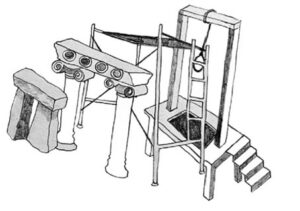by Jaime Gil de Biedma
translated from the Spanish by Leo Grossman
[view as .pdf]
scaffolding for ideas . . .
One lives among the solemn folk. Some speak
of the architrave and its problems
as they would a cousin
—a close one, at that.
Well, the architrave seems to be
in great jeopardy. No one knows
exactly why, but that’s what they say.
Some have been saying it for twenty years.
Some speak of the enemy:
elusive beings
are everywhere, insinuating themselves
like dust in bedrooms.
And there are some who raise scaffolding
to keep others from falling: careful creatures.
(Curious, that in English scaffold can be
both the platform and the gallows.)
One steps onto the street
and kisses a girl or buys a book,
strolling, happy. While they glare:
But how dare you?
¡The architrave . . . !
translator’s note: “Curioso, que en inglés, scaffold signifique / a la vez andamio y cadalso,” ponders Jaime Gil de Biedma (1929-1990) in his poem, “El arquitrabe” (translated here as “The Architrave”), an allegorical and absurd tableau of a society’s infatuation with an architectural fixture—in this case, the weight-bearing beam that lies horizontally atop two or more columns or a doorway: “Curious, that in English scaffold can be / both the platform and the gallows.”
As a translator, I often look for moments when a text opens itself up to the act of transformation and re-writing. The above is a rare instance in which my target language is directly invoked. Here, English becomes both witness and active participant, akin to a reader’s position within and without the text they approach. By calling upon another language to distill scaffold down into its set of interconnected (yet disparate) definitions, Gil de Biedma produces a small crisis of meaning that is subsequently carried back into the Spanish. As an English translator himself, drawn to the practice during a semester at Oxford in 1953, Gil de Biedma would have felt the unique quality of this crisis deeply. 1 Even encountering the poem outside of Spanish, the English reader can’t help but pause at the linguistic curio created here: The cornerstone of the poem, the personified architrave, even on this linguistic level, proves to be anything but the intricately beautiful being its proponents and caretakers believe it to be (“Some speak / of the architrave and its problems / as they would a cousin / —a close one, at that”). Illuminating this juxtaposition of the inanimate and the human, of building over body, structure over support, is Gil de Biedma’s task, and one that English speakers are particularly able to sense.
The pieces that comprise Compañeros de viaje (Fellow Travelers) (1959),2 the collection that includes “El arquitrabe,” are studies on the themes of interior and exterior realities, memory, friendship, the city, and subjecthood in post-Civil War Spain. Francisco Franco and his Falangist party’s reign was infamous for its censorship of dissenting voices—and Gil de Biedma, an educated, gay, Catalonian writer, was forced to position his work cleverly to avoid drawing unwanted attention, publishing his first works of poetry and criticism on a small scale with the help of established editor, friend and publisher Carlos Barral. The very title of the collection, which on first glance reads as a banal, romantic phrase (something like “Travel Companions”—pals or lovers holding hands while the world continues on), has a more nuanced and politically-rooted origin: The title is a Spanish translation of “попутчик” (Russian: poputchik), a Bolshevik term from the post-revolution years made popular by Leon Trotsky in Literature and Revolution (1923). Poputchik (which roughly translates to “one who travels the same path”) was first used in the USSR to describe non-party members sympathetic to the revolution, intellectuals and other ideological supporters of Communism. “Fellow traveler” stuck as the phrase’s translation in English and gained a derogatory popularity in the United States for describing non-card holding sympathizers during the Red Scare.
While attuned to the dangers and violent tenets of Franco’s ideology, Gil de Biedma, from a wealthy family (that notably fled during the Civil War to their property in Nava de La Asunción, Segovia—a geographically franquista area), understood his distance from the material and social urgency of the Spanish/Catalonian Left. This distance became even greater after his rejection from the PCE (Partido Comunista de España) on account of his sexual identity, a fate also met by his friend and well-known Catalan writer Gabriel Ferrater. The unity or kinship through rejection, a forced maturation on the margins of resistance, gives the title a secondary layer of significance which the collection carries with grace, moving through memory and deep connection with his peers, a different kind of “traveling.”
Gil de Biedma and his contemporaries of the Generación del 50—known for its explorational, introspective realism and dedication to the reconstruction of memory, understandable focal points for writers born during the Civil War—carved a new outlook into Spanish poetics. These poets, who along with Gil de Biedma included José Agustín Goytisolo, Carlos Barral, and Gloria Fuertes, reinvigorated Spanish poetics after the departure (and/or censorship) of the great Symbolists, vanguardistas, and Neo-Baroque poets of the first third of the twentieth century (Jorge Guillén, Rafael Alberti, Federico García Lorca, et al.) who either passed away or fled the country after the Falangists came to power.
Though well-known in Spain for an influential, albeit concise oeuvre, Gil de Biedma remains rather uncelebrated in the English-speaking world, even by admirers of peninsular Spanish poetry. As a result, Gil de Biedma’s work has only barely been translated into English. This may in part be due to the challenging nature of the task. His writing has a deceptive approachability; it is familiar and coherent yet carved by expertly employed grammatical and syntactical discontinuity—many phrases that appear simple or common are augmented, often suddenly, subverting the reader’s expectations. This can make translating his work difficult (certain pieces drastically more than others, as James Nolan, one of his translators, has noted).3 In his own words, Gil de Biedma describes his treatment of the familiar as a process of “creating new connections to the vulgar, decontextualizing it in order to give it a new poetic context . . . ” 4 This subversion is certainly present in “El arquitrabe”; from the ambiguous “Uno” at the beginning of the poem that denies us the certainty of a fixed subject, to the multiple speakers who emerge as the piece progresses, and finally to his play on the now defunct idiom “hablar del arquitrabe,” the source of the poem’s title, which Gil de Biedma scholar Shirley Mangini González defines as: “only [concerning] oneself with questions that are byzantine and, in reality, irrelevant.” 5 In reconstructing the idiom (quite sarcastically), the architrave becomes the faith and blind fanaticism characteristic of ruling structures materialized (read: white, polished, unmoving). For a reader familiar with the phrase, the questions of concern and import provide the structure of the poem’s critique. What is being held up? Upheld? How removed or variable can an object, phrase, or word be from its symbolic value in a given historical moment?
I attempted to maintain the shape and tone of Gil de Biedma’s language in my translation. While “hablar del arquitrabe” could not be switched out for a parallel, dated expression without changing or confusing the title of the poem altogether, I have to the best of my ability kept the vocabulary simple and familiar while also taking great care to preserve Gil de Biedma’s deliberate enjambment that seamlessly propels and softly confuses.
§ § §
A handful of pages after “El arquitrabe,” before the final section of the collection, Gil de Biedma includes an epigraph from W. H. Auden’s “Spain” (1938): a dense, fiery, and at times, similarly playful poem also concerned with the effects of the Spanish Civil War on the individual:
“What’s your proposal? To build the just city?”
The line sits on a blank page, preparing the reader for the last grouping of poems entitled “La historia para todos” (History for All). In “Spain,” Auden sings of a History that is condensed, bartered, and disseminated in broad, convenient strokes by those who hold power over its construction and retelling. The opening stanza of that poem, “Yesterday all the past / The language of size / Spreading to China along the trade-routes; the diffusion / Of the counting-frame and the cromlech; / Yesterday the shadow-reckoning in the sunny climates,” depicts a satirical and fantastical beginning to Western History.6 I was immediately struck by the physical similarity of the “cromlech,” and the structures that appear in “El arquitrabe.” I asked my friend and forever compañera de viaje, Astrid Terrazas, to sketch the four objects together: the cromlech, two columns with an architrave, some scaffolding, and gallows.
 “Untitled.” Astrid Terrazas, 2022. Pen and pencil on paper.
“Untitled.” Astrid Terrazas, 2022. Pen and pencil on paper.
JAIME GIL DE BIEDMA was born in Barcelona in 1929 to an affluent family just seven years before the onset of the Spanish Civil War. Critic, essayist, translator, and poet, Gil de Biedma is considered by many to be the preeminent voice of the Generación del 50. His work is a call to recollection, becoming, and the passing of time. It remains an invaluable reflection on society and self during Franco’s reign. He died of complications related to AIDS in 1990.
LEO GROSSMAN is an educator, musician, and translator based in Queens, New York. Leo previously acted as a translator for the asylum clinic for the New Sanctuary Coalition. His interests move between the border space, interlingualism, and the imaginative properties of sound. He is currently an MFA candidate in Literary Translation at Queens College and translation editor of Armstrong Literary.
Taking the form of mixed media painting and illustrated ceramic vessels, Mexican American artist ASTRID TERRAZAS’ (b. 1996) symbolic work re-writes worlds. Her visual language merges dreamscapes, Mexican ancestral folklore, lived experiences, and unearthly transfigurations in her own personal range of recurring motifs that function as artifacts of protection and evoke universal metaphors of transformation. She currently lives in Queens, New York.
- Gil de Biedma’s published translations are the following:
Eliot, T. S. Función de la poesía y función de la crítica (The Use of Poetry and Use of Criticism). Barcelona: Seix Barral, 1955. With an introduction by Gil de Biedma.
Isherwood, Christopher. Adiós a Berlín (Goodbye to Berlin). Barcelona: Seix Barral, 1967.
Brecht, Bertolt. La vida del rey Eduardo II de Inglaterra (The Life of Edward II of England). Madrid: La Dirección General de Música y Teatro and El Centro Dramático Nacional, 1983. Translation done with the help of friend and publisher Carlos Barral. - Gil de Biedma, Jaime. Compañeros de viaje. Barcelona: Edit. Joaquín Horta, 1959. First drafts of some of the collection appeared in:
Versos a Carlos Barral [1952]. Reproduced in Las personas del verbo. Barcelona: Galaxia Gutenberg, 2006.
Según sentencia del tiempo. Revisita Laye. nº 22. Publicación de la Delegación Provincial de Educación, Mallorca, 278, Barcelona. Enero-Marzo, 1953. - Gil de Biedma, Jaime. Longing: Selected Poems. Translated by James Nolan. San Francisco: City Lights, 1993.
- “. . . ir creando nuevas vinculaciones al término vulgar, descontextualizarlo para darle un nuevo contexto . . . ” My translation. James Valender, “Prólogo,” in Las personas del verbo, 15.
- “. . . una expresión castellana, ya en desuso, que significa discurrir solemnemente acerca de cuestionas bizantinas y, en la realidad, irrelevantes.” “[To speak of the architrave] . . . a Spanish expression, no longer in use, meaning to only concern oneself with questions that are byzantine and, in reality, irrelevant.” My translation. Shirley Mangini González, Jaime Gil de Biedma (Barcelona: Júcar, 1980), 37.
- Auden, W. H. Spain. London: Faber and Faber, 1937.

